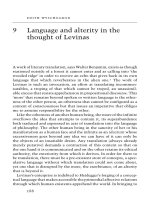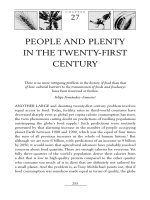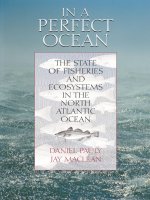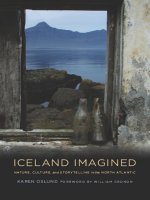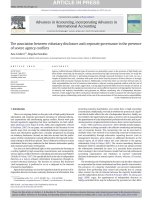iceland imagined nature, culture, and storytelling in the north atlantic
Bạn đang xem bản rút gọn của tài liệu. Xem và tải ngay bản đầy đủ của tài liệu tại đây (3.48 MB, 279 trang )
WEY ER HAEUSER ENVIRONMENTAL BOOKS
WILLIAM CRONON,
EDI
TOR
Weyerhaeuser Environmental Books explore human relationships
with natural environments in all their variety and complexity. ey
seek to cast new light on the ways that natural systems aect human
communities, the ways that people aect the environments of which
they are a part, and the ways that dierent cultural conceptions of
nature profoundly shape our sense of the world around us. A complete
list of the books in the series appears at the end of this book. ICELAND IMAGINED
Nature, Culture, and Storytelling in the North Atlantic
Karen Oslund
FORE WORD BY WILLIAM CRONON
UNIVERSITY O F WASHINGTON PRESS | SEAT TLE & LONDON
© 2011 by the University of Washington Press
Printed in the United States of America
Designed by Pamela Canell
Typeset in Minion and Gotham
Maps by University of Wisconsin Cartographic Lab
15 14 13 12 11 5 4 3 2 1
All rights reserved. No part of this publication may be reproduced
or transmitted in any form or by any means, electronic or mechani-
cal, including photocopy, recording, or any information storage or
retrieval system, without permission in writing from the publisher.
University of Washington Press
P.O. Box 50096, Seattle, WA 98145 U.S.A.
www.washington.edu/uwpress
Library of Congress Cataloging-in-Publication Data
Oslund, Karen.
Iceland imagined : nature, culture, and storytelling
in the North Atlantic / Karen Oslund
p. cm. — (Weyerhaeuser environmental books)
Includes bibliographical references and index.
isbn 978-0-295-99083-5 (hardback : alk. paper)
1. Human ecology—Iceland. 2. Natural history—Iceland.
3. Ethnology—Iceland. 4. Folklore—Iceland. 5. Iceland—
Social life and customs. 6. Iceland—Description and travel.
I. Title gf645.i25o75 2011 949.12—dc22 2010033491
e paper used in this publication is acid-free and recycled from
at least 30 percent post-consumer waste. It meets the minimum
requirements of American National Standard for Information
Sciences—Permanence of Paper for Printed Library Materials,
ansi z39.48–1984.
Title-page spread: Þingvellir lava eld; photo by William Cronon
Cover illustration: Reyðarördur, East Fjords; photo by Martin
Sejer Danielsen
Iceland Imagined is published with the assistance of a grant from
the Weyerhaeuser Environmental Books Endowment, established
by the Weyerhaeuser Company Foundation, members of the
Weyerhaeuser family, and Janet and Jack Creighton.
FOREWORD | Amid the Mists of Northern Waters and Words
by William Cronon vii
ACKNOWLEDGMENTS xiii
INTRODUC TION
Imagining Iceland, Narrating the North 3
1 | ICELAN D IC LANDSCAPES
Natural Histories and National Histories 30
CONTENTS
maps: e North Atlantic 8 | Iceland 37 | Greenland 87 | Faroe Islands 125
2 | NORDIC BY NATU RE
Classifying and Controlling Flora and Fauna in Iceland 61
3 | MASTERING THE WORLD’ S EDGES
Technology, Tools, and Material Culture in the North Atlantic 82
4 | TRANSL ATIN G AND CONVERTING
Language and Religion in Greenland 104
5 | READIN G BACKWAR D
Language and the Sagas in the Faroe Islands 123
EPILOGUE | Whales and Men
Contested Scientic Ethics and Cultural Politics
in the North Atlantic 152
NOTES 171
BIB LI O G R APHY 221
INDE X 253
VII
FOREWORD
Amid the Mists of Northern Waters and Words
WILLIAM CRONON
I
should probably confess right at the outset that I myself am among the
people described in Karen Oslund’s Iceland Imagined who have had a
life-long fascination for this remote and eerily intriguing island in the
North Atlantic. When my h-grade class back in the mid-1960s spent
a semester doing “country reports” on a chosen foreign nation, I selected
Iceland. I wrote o to the tourist bureau for maps and pamphlets, did what
research I could in the public library, and put together a detailed compi-
lation of the geographical, historical, and cultural features that make the
place so uniquely fascinating even for those who have never seen it. I still
have that report in a box in my basement and doubt I’ll ever bring myself
to throw it away.
VIII FOREWORD
As time went on, seemingly unrelated intellectual fascinations carried
me back to Iceland in unexpected ways. My youthful passion for e Lord of
the Rings led me to the realization that J. R. R. Tolkien’s scholarly expertise
as a linguist of Old English and Old Norse had enabled him to draw quite
extensively on the literature of medieval Iceland in weaving together and
even inventing languages for his vast novel. e very name he chose for the
imagined landscape in which he set his story—Middle Earth—derived in
part from the Norse word miðgarð (by way of the Old English word middan-
geard), a realm in Norse mythology in which we humans live surrounded
by a vast ocean inhabited by a world-encircling serpent named Miðgarð-
sormr. (By the way, that strange Icelandic character “ð” is pronounced like
the “th” sound in “bathe.”) Having been introduced to this mythological
world by Tolkien, I read the Icelandic sagas and Eddas, spent a year learning
Old Norse, and for a while even imagined that I would become a scholar of
the medieval North Atlantic. At almost the same time, my college studies
of geology drew me to Iceland for a very dierent reason: its location atop
the Mid-Atlantic Ridge, whose spreading boundaries have produced the
repeated volcanic eruptions and peculiar igneous landforms without which
the island would not exist. ere are few places on the planet where one
can so easily and vividly witness the consequences of plate tectonic move-
ments at rst hand. From that perspective, it was hardly surprising to me
when I learned that Jules Verne started his travelers on their Journey to the
Center of the Earth by way of a secret tunnel in the crater of the Icelandic
volcano Snæfellsjökull—and that they learned of this tunnel from a myste-
rious parchment in runic letters that falls into their hands from the leaves of
a saga by the great Icelandic writer Snorri Sturluson.
en, nally, in the 1990s, long aer I had abandoned the Middle Ages
to become a scholar of American environmental history, I had the good
fortune to hire as an assistant a woman named Salvör Jónsdóttir. Salvör, a
native Icelander, happened to be living in the small Wisconsin town that I
was then researching. Trained as a cartographer, she had been responsible
for producing a beautiful historical atlas of Reykjavík before moving to
the United States, and she would eventually return to her home country
to become the director of city planning for its capital city. It was through
Salvör’s good graces that I nally managed to visit a place that had been liv-
ing in my imagination for more than four decades. Iceland was everything
I expected it to be and far more, so that I now name it to my students as one
of those places “not to miss seeing before you die.” In making that trip at
FOREWORD IX
long last, I reenacted the kind of journey that Karen Oslund explores with
such subtlety in this remarkable book.
Oslund’s key insight in Iceland Imagined is that this distant north-
ern island has existed on the margins not just of European maps but of
European minds for over a millennium. Until the ninth century, it had
remained one of the last large islands anywhere on earth never to have been
permanently settled by human beings. (For some reason, the Inuit peoples
who rst occupied the northern latitudes from Alaska to Greenland never
made it to Iceland.) is began to change in 874 CE, when the Norwegian
chieain Ingólfur Arnarson rst settled at the place he named Reykjavík:
Bay of the Smokes. Over the next sixty years, he was followed by wave aer
wave of migrants, so that by 930 CE the coast of Iceland—really its only
inhabitable territory—was completely claimed and occupied. is “age of
settlement,” as Icelanders now call it, was recorded in a classic early history
called Landnámabók (Book of the Land-Taking), and practically everyone
now living on the island is descended from immigrants who arrived at that
time. It was all part of an extraordinary wave of outmigration from the
western ords of Norway and other parts of Scandinavia that changed for-
ever the face of northern Europe. Skilled as they were in ship construction,
maritime navigation, trade, raiding, and warfare, these Vikings, as we now
call them, ranged from Iceland, Greenland, and even Newfoundland in the
west to England, France, Russia, and the Black Sea in the east, wreaking
havoc wherever they went. In 793, they sacked the Northumbrian monas-
tery of Lindisfarne and began the ninth-century settlement of what came
to be called the Danelaw in England. A century later, they occupied the
northwest coast of France, where the province of Normandy—the name
itself means home of the Norsemen—would become the base from which
William the Conqueror would undertake the Norman Conquest of Anglo-
Saxon England in 1066. Farther to the east, comparable Viking beachheads
were established in Poland and Russia.
is Scandinavian occupation of far-ung territories had more or less
come to an end by the eleventh century. Places like Norman England and
Kievan Russia followed their own divergent histories with little relation-
ship to Scandinavia. In the Viking homeland, rst Norway and then Den-
mark asserted their authority over the lands and peoples of Scandinavia,
so that by the end of the fourteenth century Iceland had become a colony
of the Danish Crown; it would remain so until World War II. From that
point forward, Iceland—along with the Faroe Islands, which had served
X FOREWORD
as Viking waystations, and the Greenland settlements, which had died
out by the eenth century during the Little Ice Age—would recede ever
further to the outer fringes of European geopolitics and cultural life.
It is there, on the far margins of Europe, that Karen Oslund begins to
explore these northern regions. By the eighteenth century, the glory days of
the Viking Age were half a millennium in the past, and the North Atlantic
seemed very much a backwater in comparison with Enlightenment Europe.
Using a boldly kaleidoscopic approach that traces changing European per-
ceptions of Iceland and its neighbors in language, literature, geography,
science, tourism, ethnography, and politics, Oslund demonstrates the
unstable and oen contradictory ways that Iceland could be portrayed: as
an icon of wild nature; a remnant of Europe’s own medieval past; a primi-
tive exemplar of pre-modern humanity; and, in the twentieth century, a
place in which all these qualities were either transformed or threatened
(or both) by the rapid onset of modernity. In so doing, she demonstrates
the ways that Edward Said’s classic analysis of the colonial “other” can be
applied with surprisingly rich eect to Iceland, a place that is indisputably
so European and yet also so peripheral.
Travelers to Iceland in the eighteenth and nineteenth centuries, for
instance, invariably commented on the raw wildness of its terrain. e dev-
astating Laki volcanic eruptions of 1783—among the most violent in all of
recorded world history—demonstrated the explosive nature of the island’s
geology, the speed with which its landscape was capable of transforming
itself, and the challenges that human beings faced trying to make homes
there. At the dawn of an age that was increasingly fascinated by the roman-
tic sublime—those parts of nature that were roughest, darkest, most chaotic
and dangerous—Iceland seemed as wild and sublime a place as European
minds could imagine. And if romantic intellectuals were intrigued by Ice-
land’s nature, they were no less intrigued by its medieval past, so that this
same period saw the rediscovery of the Icelandic sagas, the collecting of the
manuscripts on which those ancient stories survived, and their translation
into modern languages. e sagas enjoyed a widespread literary revival—
perhaps most famously in Wagner’s operatic Ring Cycle, which combined
elements of the German Nibelungenlied with the Icelandic Völsunga saga.
(Jules Verne’s choice of an Icelandic manuscript as the starting point for
his Journey to the Center to the Earth is, of course, another example.) Sug-
gestively, the word Viking entered modern English during the romantic
age as part of this literary revival. e word derives from Old Norse víkingr
FOREWORD XI
by way of the root word vík, meaning bay or inlet—as in Reykjavík—so that
a Viking is one who frequents or comes out of bays or inlets like the ords
of Norway. e word did not exist in English until scholars and writers
popularized it in the early nineteenth century.
e great contribution of Iceland Imagined is to help us understand the
mental geographies that over the past quarter millennium have come to
dene the North Atlantic—and that teach us more than we might think
about the rest of the world. When travelers made their way to Iceland (or to
Greenland or the Faroe Islands) right up until the mid-twentieth century,
they saw themselves traversing several dierent imaginary paths. ey trav-
eled geographically outward from their European homelands to what they
saw as the far periphery of European civilization. is was the traditional
path from empire to colony, which was all the more striking in the north
because it for the most part lacked the racial overlay so apparent elsewhere.
Visitors also saw themselves moving back in time into the mythic space of
the Eddic poems and the seemingly more historical landscapes of the sagas.
Another path to the north led from the pastoral to the wild. e sublimity
of its landscapes meant that Iceland could serve as the purest European
example of nonhuman wilderness, standing in stark contrast to the domes-
ticated countrysides that travelers had le behind. And, not least, the farm-
ing, sheepherding, and shing families of coastal Iceland became icons of
a peasant past for European intellectuals who felt a decided ambivalence
about their own industrializing nations and the working-class proletarians
whose deracinated journeys from farm to factory seemed among the most
troubling symptoms of modernity. Here the traveler’s symbolic path led
toward seemingly simpler, more organic communities that were still rmly
rooted in their native soils. Even aer World War II, when Iceland joined
the rest of Scandinavia in embracing the modernism and postmodernism
of the second half of the twentieth century, it continued to straddle these
imperial/colonial, modern/premodern, inorganic/organic, unnatural/
natural oppositions in ways that displayed the country’s ambiguities and
contradictions as powerfully as anywhere in the world.
For all these reasons, Oslund argues, Iceland and the North Atlantic
have served for the past two centuries as a landscape and region for medi-
tating on a peripheral “other” that has stood as a dening counterpoint to
everything that Europe and the rest of the modern world were ceasing to
be. Partly because they were becoming modern at the same moment that
other Europeans were beginning to question the price of modern progress,
XII FOREWORD
Icelanders in particular came to pride themselves for achieving a more bal-
anced integration of nature and culture on the strange and challenging
island that was their home. By the start of the twenty-rst century, they had
long been using the geothermal energy of their volcanic landscape to pro-
duce hot water so inexpensively that there was no need to charge for it, and
they could argue with some truth that they had adopted low-carbon, envi-
ronmentally friendly alternative energies more fully than had any other
nation. Having made themselves one of the most literate and highly edu-
cated human populations on the planet, Icelanders were at the cutting edge
of the digital revolution, making their country a destination for high-tech
start-up rms willing to pay dearly for such a talented workforce. And, of
course, their growing ties to the global economy helped produce the bank-
ing crisis and attendant currency collapse of the Icelandic króna starting in
2008—clear evidence of how much the North Atlantic had become fully a
part of the modern world. One can make a similar claim about the world-
wide chaos caused by the Eyjaallajkull eruption in 2010, when volcanic
ash from Iceland disrupted air trac worldwide and stranded travelers all
over Europe for days. Both the króna collapse and the Eyjaallajkull erup-
tion oer compelling evidence for Karen Oslund’s core insight: to under-
stand the deepest paradoxes of modernity, whether they lie in the realm of
nature or culture, whether they have to do with economic globalization or
the future implications of climate change, there are few better places to go
looking for answers than Iceland and its neighbors, which are not nearly so
far away as they may seem.
XIII
ACKNOWLEDGMENTS
I
n Christina Sunley’s novel e Tricking of Freya, the Icelandic “bad boy”
Sæmundur—a stand-in for the trickster god Loki—explains to the hero-
ine why the terrain at Þingvellir is so rocky and hard for her to balance
on: “ink of the earth as an egg with its shell cracked. We are standing on
one of those cracks . . . underneath, lava rises up and pushes the two plates
apart. . . . California is on the opposite side of the North American plate.
Iceland is pushing California into the ocean!”
Finally, nally, I have an explanation for why I had to come to Iceland
from California: I was pushed. So, here, I have to thank those who pushed,
pulled, gritted their teeth, and otherwise helped bring this book into exis-
tence (with apologies to anyone I might have overlooked).
XIV ACKNOWLEDGMENTS
In California, Jim Massengale, Ted Porter, Peter Redeld, Chris Stevens,
Tim Tangherlini, Mary Terrall, and Sharon Traweek encouraged me and
read many, many dras. e UCLA History Department supported me
with fellowships during my doctoral studies, while Robert and Heidi Rudd
provided some necessary distractions and Eric Stepans supplied me with
books that were not about Iceland. My parents, Carol and Kenneth Oslund,
were the rst to show me Iceland and Greenland from above on a trans-
Atlantic ight.
When I was in Denmark, Katrine Andersen, Pelle Ove Christiansen,
Marianne Sjøholm, and omas Söderqvist welcomed me; omas Højrup
and the Institute for Archaeology and Ethnology, University of Copenha-
gen, and the Danish-American Fulbright Commission gave me a place to
study and to think about Danish-Icelandic connections. Christina Folke
Ax enlightened me with many exciting discussions about Icelandic farm-
ers, and she also performed the arduous task of reading the entire book in
proof. For seeing me through a Danish Christmas, I thank Andrea Hand-
steiner and Meike Wulfers. Martin Sejer Danielsen kindly allowed me to
use his photograph for the cover of Iceland Imagined. Across the Ørsund in
Lund, Harald Gustafsson invited me to the rst year of Icelandic seminars
at the university.
In Iceland, by hosting me, Steinn Eiríksdóttir, Sumarliði İsleifsson,
Kristján Róbertsson, Angela Walk, Ian Watson, and Þóra Sigurðardót-
tir made it possible for me to study one of the most expensive regions of
the world. In addition, Sumarliði made my work much easier by writing
such excellent books so much more quickly than I do. Hrefna Róbertsdót-
tir provided me with many sources and much encouragement, and greatly
enhanced my understanding of eighteenth-century Icelandic history.
Ingibjörg Eiríksdóttir and Sharpheðinn Þórisson generously allowed me
to use their photographs in the book and Sigmund Jóhannsson was kind
enough to let me reproduce his Keikó cartoon. Jakob Guðmundur Rúnars-
son diligently looked up sources and pictures of reindeer at Landsbókasafn
Íslands, which also deserves my thanks for allowing me to reproduce the
Ortelius map without charge.
In Great Britain, Stuart Hartley hosted me while I worked at the
National Library in Edinburgh. In London, Neil Chambers (National His-
tory Museum, London) helped me with the Joseph Banks material, and
in between Ashley Holdsworth and Ken Jukes made sure I didn’t spend
all my time in libraries. In Munich, Helmuth Trischler and the Deutsches
ACKNOWLEDGMENTS XV
Museum gave me a place to write. Whether in Germany, Iceland, or any
other place, Skúli Sigurðsson’s energy and resourcefulness in nding books
and contacts for me were inexhaustible.
In Atlanta, Georgia, Gregory Nobles at the Georgia Institute of Technol-
ogy arranged interlibrary loan privileges for me, which greatly helped with
the climate adjustment from north to south. I returned to the north again
when the Science and Technology Studies Program and the Society for the
Humanities at Cornell University hosted me for a year, supported by the
Andrew W. Mellon Foundation. During that time, Kenneth Baitsholts and
Patrick J. Stevens assisted me with the Fiske Icelandic Collection at Cor-
nell. I also thank John Carson and Gabrielle Hecht for their thoughtfulness
during a Michigan winter in Ann Arbor.
When I nally landed in the capital region, former colleagues in the
History Department at the University of Maryland, College Park, espe-
cially Robert Friedel, Andrea Goldman, and David Sicilia, oered help-
ful critiques of portions of these chapters. Some of the material in Iceland
Imagined appeared previously in the British Journal for the History of Sci-
ence, in Environment and History, and in my co-edited volume with David
L. Hoyt, e Study of Language and the Politics of Community in Global
Context, 1740-1940 (Rowman and Littleeld, 2006). e American Council
of Learned Societies and a Mellon Fellowship allowed me to spend a year
at the John Kluge Center with the collections at the Library of Congress.
e German Historical Institute (GHI), Washington, D.C., and especially
its former director, Christof Mauch, deserve my thanks for understand-
ing why the Institute should hire someone writing about a place that was
neither Germany nor America, but somewhere in between. My colleagues
at the GHI, especially Richard Wetzell, also gave me constructive criticism
on some of this material during my time there. My colleagues in the Tow-
son University History Department have consistently and warmly oered
me a stimulating atmosphere in which to think about the North Atlantic
and the world. I also thank its chair, Robert Rook, for securing nancial
support for the picture reproductions in Iceland Imagined.
At the University of Washington Press, the advice of Marianne Ked-
dington-Lang, William Cronon, and four anonymous reviewers greatly
improved the book. Copyeditor Julie van Pelt had a superb eye for detail,
designer Pamela Canell made the pictures complement the text beauti-
fully, and managing editor Marilyn Trueblood expertly steered the book
through the entire process.
XVI ACKNOWLEDGMENTS
en there are the people who were everywhere, all the time: my hus-
band, omas Zeller, who came in late one morning in Berlin, but never
leaves before the end, even if that means having to read two hundred pages
about places north of the Alps. Our children, Tobias and Sebastian, deserve
my thanks for being good travelers and for not letting their parents write
long books. I hope they will also be pushed and pulled by forces of their
own making to one edge of the world and another.
K.O.
1
ICELAND IMAGINED
3
O
n my rst visit to Iceland, an Icelandic acquaintance took me for
a driving tour around the Reykjanes peninsula. On this south-
western corner of the island, the capital of Reykjavík is sur-
rounded by a cluster of outlying suburbs and neighboring communities
where almost two-thirds of Iceland’s approximately 317,000 inhabitants
live. As we passed over trac bridges between Reykjavík and the old port
town of Hafnarörður, I thought about the visual contradictions of the Ice-
landic landscape. Signs of modernity mark the city; for a European capital,
Reykjavík appears strikingly new. Őskjuhlið, the silver-grey geothermal
water towers topped by a gourmet restaurant, Perlan (e Pearl), is some-
times jokingly compared to a UFO because of the sleek, high-tech appear-
INTRODUCTION
Imagining Iceland, Narrating the North
For Europe is absent. is is an island and therefore Unreal.
—W. H. Auden (1937)
Few outside the Scandinavian world know much about Iceland. . . .
To write about early Iceland and intend to be understood is to supply
background that would be inappropriate if supplied by the historian
whose turf had the (mis)fortune to become populous, powerful, and
central to the story western nations like to tell about themselves.
—William Ian Miller (1990)
4 INTRODUCTION
ance of its dome. e architecture of the University of Iceland (Háskóli
Íslands), founded in 1911, is modernistic and functional. e Nordic House
(Norræna Húsið) on the university campus was designed by the Finnish
architect Alvar Aalto in his distinctive Scandinavian modern style, and the
National Library of Iceland (Landsbókasafn Íslands), with its courtyard
fountain and café, might strike the visitor as the entrance to a shopping
mall rather than a research institution. Kringlan, one of the actual Reykja-
vík shopping malls located at the other end of one of the major thorough-
fares from the university, uses high ceilings, windows, and natural light in
a way that I found more appropriate to the sunnier climes of Los Angeles
than to cloudy, drizzly Iceland that summer.
When I le Los Angeles for Iceland, I had imagined that I was going to
“Europe” and thought of the features of European built landscapes that
Americans are trained to be impressed by: cathedrals, castles, and monu-
ments, structures that derive their historical authority through their age
and their memory of the past. In Iceland, a historical memory invoked by
the built landscape seemed to be missing at rst glance.
If the Icelandic cityscape seems modern, so too does the Icelandic
soundscape. Since the early 1990s, Iceland has been marketed by the tour-
ist industry as a site of breaking pop culture and electronic music. e
notoriously frantic Reykjavík weekend “pub crawl” (rúntur) is noted in
the guidebooks as an attraction equal to Hallgrímur’s Church (Hallgríms-
kirkja) and the National Museum (Þjóðminjasafn Íslands) for the foreign
understanding of Icelandic culture. In the mid-1980s, the Icelandic art col-
lective Bad Taste (Smekkleysa) launched itself with the manifesto of reject-
ing the established conventions of the Icelandic art world. e most famous
artists to emerge from the collective on to the international scene have been
Björk and the Sugarcubes, although many other Icelandic bands, includ-
ing Sigur Rós, Gus Gus, and Mum, have also become internationally well-
established. e tension between this Icelandic modernity and notions of
its history and traditional beliefs has even provoked a cynical commentary
from Björk herself, who remarked that “when record company executives
come to Iceland they ask the bands if they believe in elves, and whoever
says yes gets signed up.”
Iceland does have a long written history, but, as I was beginning to
understand that summer, its history was not the kind that le its mark on
the landscape. e architecture and sounds of Reykjavík might be modern,
INTRODUCTION 5
but Icelandic history, as it is told in that country and elsewhere, is almost
exclusively concerned with the remote past. As I had learned during the
prior month, in Iceland a foreign student is always assumed to have come
in order to study the medieval sagas—the stories that were written about
the earliest days of Icelandic settlement from Norway, the Viking-age
period of Icelandic independence from about 871 to about 1262. Icelandic
tourist brochures promote the country as the “land of the sagas” where one
can still experience aspects of the “age of the Vikings.” Since the beginning
of saga study in Europe in the seventeenth century, this period in Icelandic
history has been considered the golden age (gullöld) of Icelandic literature
and culture, when the events of many of the Old Norse sagas took place and
Eddic poems were composed. Tales about the heroic Leifur Eiríksson and
his discovery of North America, of Viking warriors like Ragnar loðbrók
(Ragnar the Hairy Pants) and Egill Skallagrímsson—who, when captured
by his arch-enemy the Norwegian king Eiríkur blóðöx (Erik of the Bloody
Ax) saved his own life by composing a poem so magnicent that it moved
the king to mercy—continue to dominate the historical narrative of the
country.
For centuries, the saga literature has been a major source of for-
eign interest in Iceland, and it was natural that Icelanders would casually
assume that a foreign student was there to study it.
When foreign travelers came to Iceland, as they did in increasing num-
bers beginning in the eighteenth century, obsessed by catching a glimpse
of the “sites of the sagas,” they traveled for long distances, oen in di-
cult conditions, and they were frequently rather disappointed by what they
saw. If you visit Bergþórshvoll in southern Iceland, which tourist brochures
typically describe as the “site of Njáls Saga, the most famous of the Ice-
landic sagas,” you may well see nothing in particular that stands out.
A
modern farmhouse on a low mound is all that represents the farmstead of
the tenth-century farmer Njáll Þorgeirsson and his last stand with his sons
against the men who burned his home with his family inside. If one looks
to the landscape for history, as the tourist eye is instructed to do, the land-
scape reveals very little, and certainly nothing so obvious as a medieval
castle with reconstructed walls and a museum and a gi shop next door.
e medieval history, the period of Icelandic greatness, has le but little
impression on the landscape.
For a traveler better educated in Icelandic history, all of this might
have been less striking. Even a few moments of reection on the poverty
6 INTRODUCTION
of the Icelandic past and the inhabitants’ inability to build lasting struc-
tures of the type to satisfy the naïve expectations of later travelers would
have helped to resolve this contradiction in my mind. Indeed, my Icelan-
dic acquaintance seemed unimpressed by my musings. “Well,” she said,
“you have to remember that, except for the technology, we’re a third world
country.” Although one risks cliché here, I came to think of this as a “typi-
cally Icelandic” remark: laconic, ambiguous, perhaps critical of Iceland
and its inhabitants, or perhaps of foreign expectations of the country. If
it was meant to be the latter, she surely had grounds for this: while I was
naïve about Iceland on my rst visit, at least I wasn’t the only one. Since
the eighteenth century, European and American writers have been think-
ing, describing, classifying, imagining, and writing about Iceland and the
North Atlantic region with surprise and wonder about its “contradictions,”
“paradoxes,” and “extremes.” eir stories, the reactions of the natives to
their stories, and the consequences of these narratives and counternarra-
tives for the region, are the topic of this book.
At that moment in Iceland that rst summer, however, the idea of Ice-
land as part of the third world only intensied my surprise, curiosity, and
lack of understanding. What does it mean, to be a “third world country
except for the technology”? Since the term “third world” was invented aer
World War II, it has been used primarily to signify impoverished regions
of technological underdevelopment.
ose areas of the globe designated
the third world and thus coded decient, in need of modernization, West-
ernization, and industrialization were most oen the former colonies of
Western powers in Africa, Southeast Asia, or Central and South America,
regions considered to be well outside the main trajectories of European
history. According to the schema outlined by this classication, these were
places acted upon by Westerners and rendered passive, static, and outside
of historical time.
In a series of historical moments, eighteenth-century
Enlightenment thinkers, colonial administrations of the nineteenth cen-
tury, and post–World War II aid programs modeled on the Marshall Plan
delineated the deciencies of the regions and people outside the areas where
they themselves lived. Although the Enlightenment, colonialism, and the
Marshall Plan are considerably dierent from each other, they share a ten-
dency toward dualism, dividing the world between the modern self and the
nonmodern, primitive, others.
So where and what is Iceland? Is it part of “Europe” or a technologically
INTRODUCTION 7
advanced and prosperous part of the “third world?”
Or is it something in
between? Categorizing Iceland, or any other country, as part of “Europe” or
as part of the “third world” helps to reveal what these terms mean, as their
meaning is continually being explained and dened through use. Accord-
ing to which standards of measurement can we call this small island in the
North Atlantic European? If we nd it dierent in some way, in some way
not European, as European travelers to Iceland from the eighteenth to the
mid-twentieth century oen did, how are these dierences then used to
dene European norms? e anthropologist Fredrik Barth has pointed out
that identities are constructed at borders, at the points where dierences
can be seen most clearly.
By looking at the edges of Europe in the North
Atlantic, we can understand what it means to be European by identify-
ing which aspects of life on these borders traveling Europeans found to be
exotic, strange, and disconcerting.
Iceland Imagined examines how Iceland and the rest of the North Atlan-
tic region, which includes Greenland, northern Norway, and the Faroe
Islands (see map 1), have been envisioned by travelers and observers from
the eighteenth century to the time of the Second World War. (e epilogue
discusses certain developments in late-twentieth- and twentieth-rst-cen-
tury Iceland that parallel the themes of the earlier period.)
is book is also a cultural history of the North Atlantic as a Euro-
pean periphery. e North Atlantic, which was in the eighteenth century
a marginalized region of the Danish-Norwegian kingdom, was gradu-
ally transformed—culturally, environmentally, and technologically—into
modernity. Considered an exotic and unfamiliar wilderness by travelers
from western Europe when the story begins, the North Atlantic was, by
roughly the end of World War II, generally understood as belonging to
the developed areas of the world. e image of a wild and untamed North
Atlantic frontier, lled with dangerous nature and unpredictable inhabit-
ants, was gradually transformed into a place of beautiful, well-regulated,
and manageable nature, inhabited by simple but virtuous people. Iceland
Imagined analyzes the process of this change by looking at the people who
participated in it—both in the North Atlantic and those looking at the
region from outside—and their reasons for considering the North Atlantic
a “wilderness” or a “homeland.” When they looked at the nature, the land-
scape, the language, or the material conditions of the North Atlantic, they
read into these observations a position for the North Atlantic on the globe.
MAP 1 . TH E NORT H ATLANTIC

